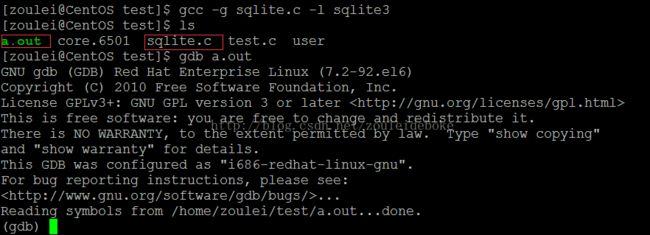linux下gdb调试基本命令学习
我们知道软件开发,调试技能是一个必备技能,学会调试就能快速高效地抓到bug,而gdb 是 GNU 调试器,Linux 上的标配调试器。下面我就对我所学到的一些在linux下gdb调试命令进行一下总结:
命令描述:
backtrace(或bt): 查看各级函数调用及参数
finish : 连续运行到当前函数返回为止,然后停下来等待命令
frame(或f): 帧编号选择栈帧
info(或i): locals查看当前栈帧局部变量的值
list(或l) : 列出源代码,接着上次的位置往下列,每次列10行list 行号列出从第几行开始的源代码list 函数名列出某个函数的源代码
next(或n): 执行下一行语句
print(或p): 打印表达式的值,通过表达式可以修改变量的值或者调用函数
quit(或q): 退出gdb调试环境set var修改变量的值
start : 开始执行程序,停在main函数第一行语句前面等待命令
step : (或s)执行下一行语句,如果有函数调用则进入到函数中
下面以我自己编写的操作数据库的sqlite.c文件进行演示:
1.进入gdb
#(gdb) a.out
[zoulei@CentOS test]$ gdb a.out
也可以直接在命令行输入gdb,进入gdb后在提示符(gdb)后输入要调试的可执行文件a.out,不过还要加入gdb的file命令如图:
[zoulei@CentOS test]$ gdb
2.查看源码
#(gdb)list
(gdb) help l
List specified function or line.
With no argument, lists ten more lines after or around previous listing.
"list -" lists the ten lines before a previous ten-line listing.
One argument specifies a line, and ten lines are listed around that line.
Two arguments with comma between specify starting and ending lines to list.
Lines can be specified in these ways:
LINENUM, to list around that line in current file,
FILE:LINENUM, to list around that line in that file,
FUNCTION, to list around beginning of that function,
FILE:FUNCTION, to distinguish among like-named static functions.
*ADDRESS, to list around the line containing that address.
With two args if one is empty it stands for ten lines away from the other arg.
(gdb) l
21 int len;
22 int i=0;
23 int nrow=0;
24 int ncolumn = 0;
25 char *zErrMsg =NULL;
26 char **azResult=NULL; //二维数组存放结果
27 /* 打开数据库 */
28 len = sqlite3_open("user",&db);
29 if( len )
30 {3.设置断点
#(gdb)break n
(gdb) b 20
Breakpoint 1 at 0x80486cd: file sqlite.c, line 20.
(gdb) run
Starting program: /home/zoulei/test/a.out
[Thread debugging using libthread_db enabled]
Breakpoint 1, main (argc=1, argv=0xbffff774) at sqlite.c:20
20 sqlite3 *db=NULL;
Missing separate debuginfos, use: debuginfo-install glibc-2.12-1.166.el6_7.3.i686 sqlite-3.6.20-1.el6.i686n表示在哪一行设置断点,上面会在运行到源码第20行时停止,可以查看变量的值、堆栈情况等;这个行号是gdb的行号。
4.查看断点处情况
#(gdb)info breakpoints
(gdb) info breakpoints
Num Type Disp Enb Address What
1 breakpoint keep y 0x080486cd in main at sqlite.c:20
breakpoint already hit 1 time
#(gdb)delete +要取消的断点
(gdb) delete 1
(gdb) info breakpoints
No breakpoints or watchpoints.
(gdb)下面我就4.5.6三个步骤进行演示:
(gdb) break 60
Breakpoint 1 at 0x804884f: file sqlite.c, line 60.
(gdb) run
Starting program: /home/zoulei/test/a.out
[Thread debugging using libthread_db enabled]
You have opened a sqlite3 database named user successfully!
table SensorData already exists
Breakpoint 1, main (argc=1, argv=0xbffff774) at sqlite.c:61
61 sql="select *from SensorData";
Missing separate debuginfos, use: debuginfo-install glibc-2.12-1.166.el6_7.3.i686 sqlite-3.6.20-1.el6.i686
(gdb) delete 1
(gdb) info breakpoints
No breakpoints or watchpoints.
(gdb) break 70
Breakpoint 2 at 0x80488f7: file sqlite.c, line 70.
(gdb) run
The program being debugged has been started already.
Start it from the beginning? (y or n) y
Starting program: /home/zoulei/test/a.out
[Thread debugging using libthread_db enabled]
You have opened a sqlite3 database named user successfully!
table SensorData already exists
nrow=33 ncolumn=5
the result is:
Program received signal SIGSEGV, Segmentation fault.
0x00bc7a4f in __strlen_ia32 () from /lib/libc.so.6
(gdb)6.单步调试
#(gdb) step
# (gdb) next
(gdb) start
The program being debugged has been started already.
Start it from the beginning? (y or n) y
Temporary breakpoint 3 at 0x80486cd: file sqlite.c, line 20.
Starting program: /home/zoulei/test/a.out
[Thread debugging using libthread_db enabled]
Temporary breakpoint 3, main (argc=1, argv=0xbffff774) at sqlite.c:20
20 sqlite3 *db=NULL;
(gdb) step
22 int i=0;
(gdb) next
23 int nrow=0;
(gdb) bt
#0 main (argc=1, argv=0xbffff774) at sqlite.c:23
(gdb) next
24 int ncolumn = 0;
(gdb) next
25 char *zErrMsg =NULL;
(gdb) next
26 char **azResult=NULL; //二维数组存放结果
(gdb) next
28 len = sqlite3_open("user",&db);
(gdb) bt
#0 main (argc=1, argv=0xbffff774) at sqlite.c:28
(gdb) step
29 if( len )
(gdb) bt
#0 main (argc=1, argv=0xbffff774) at sqlite.c:29#(gdb)backtrace
程序运行如果出错,立即执行bt命令,即可看出出错的堆栈地址及相应的出错代码行。
(gdb) run
Starting program: /home/zoulei/test/a.out
[Thread debugging using libthread_db enabled]
You have opened a sqlite3 database named user successfully!
table SensorData already exists
nrow=51 ncolumn=5
the result is:
Program received signal SIGSEGV, Segmentation fault.
0x00bc7a4f in __strlen_ia32 () from /lib/libc.so.6
Missing separate debuginfos, use: debuginfo-install glibc-2.12-1.166.el6_7.3.i686 sqlite-3.6.20-1.el6.i686
(gdb) bt
#0 0x00bc7a4f in __strlen_ia32 () from /lib/libc.so.6
#1 0x00b9223f in vfprintf () from /lib/libc.so.6
#2 0x00b99210 in printf () from /lib/libc.so.6
#3 0x080488de in main (argc=1, argv=0xbffff774) at sqlite.c:67感觉gdb调试还是蛮容易学的!无非就是了解这些命令知道怎么用就行。
目前我只学到了这些基本的gdb调试命令,我知道gdb还有很多的命令,因为没用到过,就暂时总结到这里了,以后若学到好的调试方法,再来更新!

